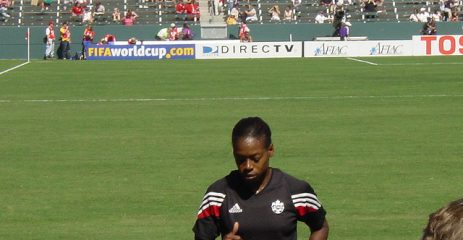FIFA was recently asked to reform it’s governance structures and become more representative and inclusive of women’s soccer.
It was also asked to reflect upon the fact that investment is world soccer is skewed.
Presented below is a summary of the case presented to the FIFA reform committee.
The case for reform prepared by Moya Dodd and Sarai Bareman
The Academy of Sport was invited to support the bid by Monika Staab Global Fellow and FIFA ambassador for women’s football.
Under pressure from authorities, commercial partners and stakeholders within, FIFA is in need of imminent change. The opportunity to reform and produce a more equitable governance structure exists now.
Key facts at November 2015
-

Women’s World Cup Soccer 111 years after FIFA was formed, women are still vastly under-represented at every level of the pyramid in the world game.
- The European Commission recently called for minimum 30% gender representation in international sports governing bodies, 40% in national sports governing bodies, with a minimum 40% in management.
- FIFA Women’s Football Survey 2014 shows CONMEBOL (2%) and UEFA (6%) have the lowest % of women on Executive Committees of member associations.
- FIFA’s first women’s football tournament was held in 1988; the first FIFA Women’s World Cup in 1991, and women’s football was first played in the Olympics in 1996.
- Currently, FIFA still holds only men’s competitions in club football, futsal, and beach soccer.
- In March 2015, FIFA signed the Brighton + Helsinki Declaration, affirming the organization’s commitment to gender equality.
McKinsey measured the “organizational excellence” of companies in Europe, North America, and Asia by evaluating them on nine organizational criteria. When they examined the senior management teams of these companies, they found that those with three or more women had higher scores, on average, than teams with no women.
McKinsey found that the score increased significantly once critical mass was reached—about one-third women (Women Matter: A Corporate Performance Driver, McKinsey 2007).
What is the problem?
Football today is overwhelmingly male – not because women and girls are inherently disinterested or but rather due to decades of institutional and social barriers that prevent them from playing. When girls don’t play, women’s equity in leadership in technical, administration and governance remains under-realized.
 Too few decision makers in football appreciate the nature and scale of the issue. At the 2015 FIFA women’s football symposium delegates from 171 member associations presented calls for reform that would fundamentally alter football’s profile.
Too few decision makers in football appreciate the nature and scale of the issue. At the 2015 FIFA women’s football symposium delegates from 171 member associations presented calls for reform that would fundamentally alter football’s profile.
Given that women constitute an enormous opportunity with for football such measures would serve FIFA’S objectives.
Women are under-represented in decision-making
Women comprise only 8% of ExCo members globally. At Confederation level, only 8 women hold ExCo positions, and some Confederations have none.
Within FIFA itself, there are 3 women out of 26 ExCo members; the Standing Committees contain hardly any women (outside the women’s football committees) and only one Director is female.
Globally, just 2 of 209 Member Association Presidents are women – less than 1% of the voting population in FIFA Congress – and in the majority of Confederations there are none at all.
Only 7% of registered coaches are female, and they battle a “grass ceiling” despite their qualifications and disproportionate success.
It is not only football that has disproportionately low female participation in decision-making: it is a pattern in society generally. Improving this ratio is now recognised as a major driver of social and corporate value.
A large body of emerging research shows materially positive effects of gender balancing, such as:
- 26% better share price, where at least one women is on the board.
- 56% better EBIT and 41% better Return on investment than that achieved by all-male executive committees.
- reduced severity and frequency of fraud.
Women’s football is under-resourced

Even though FIFA outlaws discrimination, it is still the case that many girls grow into women without having the chance to play in a team or know how it feels to score a goal.
Those who do get less opportunities, fewer competitions, reduced support and diminished rewards compared to their male peers, largely because historical, social and institutional bans have delayed competitions and affected development.
Barely 40% of member associations offer girls grassroots programs18 and all around the world, competitions and playing pathways are more limited. Even in FIFA itself, development funds dedicated to women’s football amount to only a modest share of the total.
Football’s stated ideal of ‘no discrimination’ has not yet translated into the active provision of equal opportunities for girls and women to participate in football.

As the biggest and most popular sport in the world, football is well-placed to invest in its largest, least-developed “greenfields” opportunity – the women’s game.
The impact would be transformative. With fair and proportionate resourcing, football can become the leading sport for women in the world – as it deserves to be, and as it already is for men.
Why is this a matter for the FIFA Reform Committee?
FIFA needs to rehabilitate its own image, and the image of football. Addressing gender imbalance is a visible and convincing means to demonstrate that this Reform Committee, FIFA and football are prepared to lead rather than lag society, and be a vehicle for progress.
It will build FIFA’s equity among the stakeholders of today and tomorrow, recognizing the fundamental shift in society’s expectations, and this will contribute enormously to rebuilding the credibility of FIFA, and football, in the eyes of the watching world.

Better gender balance of itself will deliver improvements in critical aspects of football’s governance by creating a better, more diverse decision-making environment and a culture that is less prone to corruption.
FIFA urgently needs both, and has been pressed by, and made promises to, various bodies.
- In March 2015, FIFA signed the Brighton + Helsinki Declaration, affirming the organisation’s commitment to gender equality. In pursuance of that commitment, FIFA should increase equality measures within its own governance systems.
- It has also been called upon by the European Commission to ensure better gender balance in decision-making, as well as members of the US Congress.
- FIFA has been urged to act by stakeholders within FIFA, including the Women’s Football Symposium in July 2015 and the Task Force for Women’s Football in August 2015.
Proposals
Inclusion in decision-making
The Reform Committee is respectfully requested to recommend an immediate 20% presence of women on the FIFA Executive Committee, to be mirrored within a reasonable time at all levels (Confederations, MAs, clubs, etc) with a longer-term target of 30% gender balance.
Investment in the women’s game
The Reform Committee is respectfully requested to recommend an immediate requirement for all football stakeholders (including governing bodies and clubs) to actively resource participation opportunities for women and girls at all levels, without gender discrimination in fair financial proportion to its female participation and potential.



